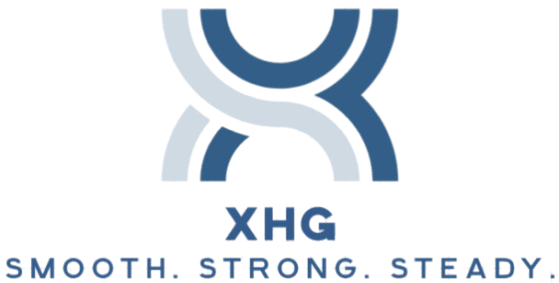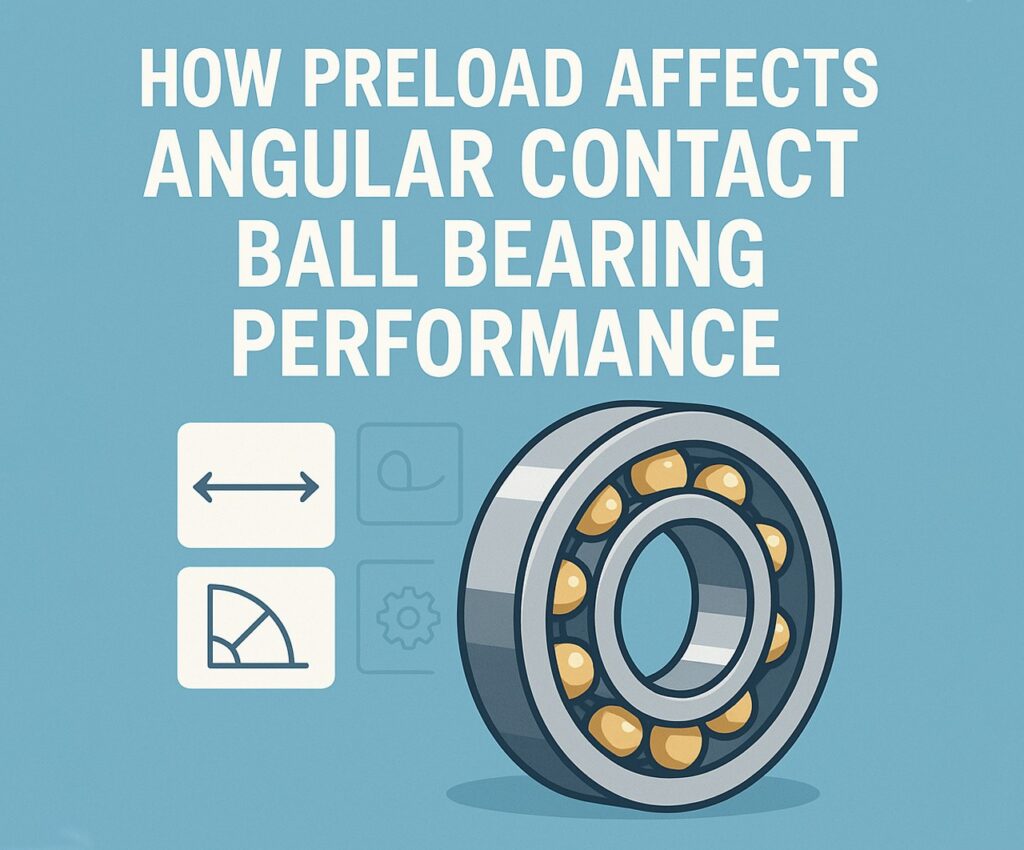When designing precision equipment or high-speed machinery, the performance of angular contact bearings plays a pivotal role. Whether analyzing the angular contact ball bearing contact angle, reviewing an angular contact ball bearing drawing, or sourcing from a reliable angular contact ball bearing manufacturer, preload emerges as a critical factor that directly influences stability, load capacity, and service life. Understanding how preload affects bearing geometry, contact angle, and operational conditions is key to unlocking peak performance and long-term reliability. Know More
What Is Preload in Angular Contact Bearings?
Preload refers to the intentional internal axial force applied to a bearing during assembly to remove internal clearance and maintain consistent contact between rolling elements and raceways. In angular contact bearings, this force is applied in the direction of the contact angle, ensuring optimized stiffness and reduced deflection under load.
Unlike standard radial bearings, angular contact bearings are engineered to support combined radial and axial loads. This is made possible by their unique design, which includes a defined angular contact ball bearing contact angle—typically ranging from 15° to 40°—to determine the direction and efficiency of axial load support.
How the Contact Angle Affects Preload Behavior
The angular contact ball bearing contact angle is the angle between the line of action of the load through the contact point of the balls and the radial plane of the bearing. This angle is crucial for defining the direction in which the bearing can resist axial forces.
- Smaller angles (e.g., 15°): Favor high-speed rotation with less axial load support.
- Larger angles (e.g., 30°–40°): Support higher axial loads but limit speed capacity.
When preload is applied, it changes the internal geometry of the bearing slightly, causing the contact angle to shift. The preload increases the contact surface between the ball and raceway, enhancing stiffness and load distribution but also generating internal stress that must be balanced carefully.
Types of Preload in Angular Contact Bearings
There are two primary preload approaches:
1. Fixed Preload (Built-in)
Preload is built into the bearing set during manufacturing. This is common in matched sets or paired arrangements where consistency is key.
2. Adjustable Preload (External Adjustment)
Achieved during assembly by adjusting spacers, shims, or locknuts. This allows engineers to tailor preload based on system dynamics.
Matched bearing sets are often described using terms like:
- Back-to-back (DB): Increases rigidity, handles overturning moments.
- Face-to-face (DF): Tolerates misalignment better.
- Tandem (DT): Increases axial load capacity in one direction.
A good angular contact ball bearing drawing will typically show the preload direction and contact angle to aid in proper assembly.
The Relationship Between Preload and Performance
Preload significantly impacts multiple performance parameters of angular contact ball bearings:
1. Rigidity and Stiffness
In high-precision machines (e.g., CNC spindles), rigidity is critical. Preload reduces deflection and enhances positional accuracy. Too little preload leads to looseness; too much increases friction and heat.
2. Rotational Accuracy
Preloaded bearings maintain consistent ball contact, reducing shaft runout and enhancing rotational precision. This is essential in high-speed grinders and semiconductor equipment.
3. Vibration Damping
A correctly preloaded bearing assembly absorbs micro-vibrations better, reducing system noise and wear—important in robotics and measuring devices.
4. Speed Capability
Higher preload increases friction, reducing allowable speed. Therefore, the selected preload must balance speed and rigidity requirements.
5. Thermal Stability
As temperature rises during operation, bearing components expand. If preload is too high, thermal growth can lead to excessive internal loads, accelerating wear or failure.
A reputable angular contact ball bearing manufacturer will offer guidance on recommended preload values for specific applications and environments.
Consequences of Improper Preload
Under-Preload
- Increased vibration and noise
- Poor accuracy and shaft deflection
- Ball skidding and uneven wear
- Decreased bearing life
Over-Preload
- Excessive heat generation
- Increased power consumption
- Higher risk of lubricant breakdown
- Premature fatigue and fracture
Correct preload setting depends on application type, bearing arrangement, contact angle, and system rigidity.
Tools for Calculating and Setting Preload
To ensure optimal preload, engineers use several methods:
- Axial Displacement Measurement: Uses dial indicators to measure shaft movement under load.
- Torque Monitoring: Observes changes in rotational resistance during adjustment.
- Preload Springs: Apply constant force to maintain preload over temperature changes.
- Thermal Compensation Models: Account for expansion and material behavior over operational ranges.
Most angular contact ball bearing manufacturer catalogs offer preload calculation charts based on contact angle, ball diameter, and application force levels.
Application-Specific Preload Considerations
Machine Tool Spindles
Require high rigidity and minimal runout. Matched DB pairs with high preload and 15° contact angles are common.
Medical Equipment
High-speed centrifuges or imaging machines use low preload with smaller angular contact ball bearing contact angle to maximize speed while minimizing wear.
Automotive Turbochargers
Bearings must handle rapid acceleration and deceleration. Medium preload offers a balance between speed and stability.
Aerospace Control Systems
Precision under thermal variation is critical. Bearings are preloaded with spring systems or thermal compensators.
When selecting a bearing, an angular contact ball bearing drawing should be reviewed to determine preload compatibility, mounting configuration, and contact angle specification.
Importance of Manufacturer-Specific Guidelines
Each angular contact ball bearing manufacturer may use proprietary materials, surface treatments, or design variations. This means preload recommendations can vary significantly.
Look for manufacturers who provide:
- Preload setting charts by bearing series
- Matched pair kits with factory preload
- Custom preload configurations
- CAD-compatible angular contact ball bearing drawing resources
Top-tier brands also offer simulation services to model preload behavior in dynamic systems.
Innovations in Preload Optimization
Smart Bearings
Integrated sensors monitor preload, load distribution, and thermal shifts in real time—feeding data into predictive maintenance systems.
Advanced Coatings and Materials
Low-friction coatings and ceramic hybrid bearings allow higher preload without excess heat buildup.
Dynamic Preload Mechanisms
Systems that adjust preload during operation using mechanical or piezoelectric actuators are being tested in aerospace and defense sectors.
These innovations allow preload to become a tunable, adaptive parameter, pushing the performance of angular contact bearings even further.
Maintenance and Inspection Tips
- Check preload during scheduled maintenance using torque or endplay gauges.
- Monitor bearing temperature and noise levels as early warning signs of preload loss.
- Reapply assembly torque values if bearing housing has been disturbed.
- Use thermal imaging during startup cycles to identify preload-sensitive zones.
Always refer to the original angular contact ball bearing drawing or assembly guide to verify correct reinstallation.
Preload and Bearing Lifespan
Proper preload can significantly extend bearing life by:
- Preventing edge loading
- Ensuring even wear across contact surfaces
- Reducing shock loads on balls and raceways
Incorrect preload, by contrast, can halve or even quarter a bearing’s expected service life—making precision setup a cost-saving strategy as much as a performance factor.
Final Thoughts
Preload is not just a technical adjustment—it’s a core part of how angular contact ball bearings achieve their exceptional performance in critical systems. Whether you’re selecting based on the angular contact ball bearing contact angle, reviewing an angular contact ball bearing drawing, or collaborating with a trusted angular contact ball bearing manufacturer, preload should always be at the center of your design and maintenance decisions.
By understanding how preload affects rigidity, speed, thermal stability, and wear, engineers can unlock the full potential of these precision components—ensuring smooth operation, minimized downtime, and maximized machine life.

